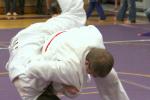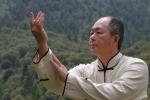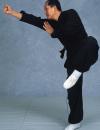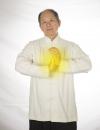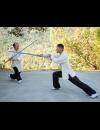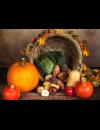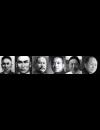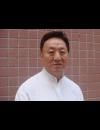The Language of Judo
May 13, 2024
Speaking Japanese is different than “speaking Judo.” But for those who want to have a better understanding and appreciation of judo, learning how to “speak Judo” opens up the whole world of judo to them.
5 Min Read
Judo: Basics Win Matches
April 22, 2024
No one has ever walked onto a judo mat and immediately became an elite-level athlete. Anyone who thinks otherwise will have a short and limited career in judo. 6 Min Read
YMAA Celebrates 41st Anniversary
October 2, 2023
In honor of the 41st Anniversary of YMAA, join us on our YouTube channel for a special commemorative video.
Master Cheng Gin Gsao
October 3, 2022
Dr. Yang, Jwìng-Mǐng trained as a teenager beginning at age 15 with Master Cheng, Gin Gsao (曾金灶) learning Shaolin White Crane Kung Fu. Because Jwìng-Mǐng had a painful ulcer since childhood, Master Cheng recommended he might learn Taijiquan because he had heard of its healing benefits. This shows how special Master Cheng was…
Meet the Author: Dr. Yang, Jwing-Ming interview with Gene Ching discussing the YMAA 40 Year Anniversary (video)
September 28, 2022
Dr. Yang, Jwìng-Mǐng (楊俊敏博士) chats from his new home in upstate California with YMAA staff writer Gene Ching about the YMAA 40-year anniversary.
The Leg Scissors and Its Descendent: The Triangle
-
August 1, 2022
So, for the purposes of understanding how the triangle choke has evolved and how it will continue to develop, it’s best to say that it is an offspring with many parents come from many parts of the world.
The YMAA Kung Fu Curriculum
-
April 18, 2022
This is Dr. Yang, Jwing-Ming's official YMAA External Arts Curriculum, which outlines his recommended order of study for Kung Fu students.
The YMAA Qigong Curriculum
-
February 21, 2022
The Chinese word Qi (氣) is defined as energy, as in all energy in the universe, and Gong means hard work or study. Therefore, Qigong (氣功) means "the study of natural energy." Western science has identified a bioelectric potential in the body which could be one of the primary aspects of Qi energy. This "bioelectricity" is recognized by YMAA as an important area of Qigong study and research.
Judo - Skill Is the Practical Application of Technique
-
January 13, 2020
The words technique and skill are often used to mean the same thing, yet they are separate and interdependent. This article is devoted to exploring what skill and technique are, and why it's important to understand how they work.
The Core Concepts of Throwing Techniques
-
December 30, 2019
The purpose of a successful throwing technique in sambo is to get an opponent to the mat or ground as effectively as possible with control. A sambo grappler can win a match outright by a total victory by throwing his opponent to the mat with control (largely on the back or backside, or if the opponent lands in a bridge) with the thrower remaining standing at the conclusion of the throw.
Teaching, Learning and Training for Juji Gatame
-
September 30, 2019
Juji gatame is a core skill for all combat sports. The study of this armlock teaches fundamental skills that go beyond simply stretching an opponent’s arm. It is a useful, reliable tool with a high rate of success used in all combat sports and can be used by both male and female athletes in all weight classes.
Juji Gatame: The World’s Most Popular Armlock
-
April 29, 2019
There are, fundamentally, two core ways of “locking” an arm. You either bend it over a fulcrum to cause pain or you straighten and stretch it over a fulcrum to cause pain. Juji Gatame is one of four primary armlocks that attack the elbow joint (as well as shoulder joint).
YMAA Tai Chi and Internal Arts Curriculum
-
April 22, 2019
At YMAA, students learn qigong (energy cultivation) as part of their taiji or kung fu classes. In ancient times, Shaolin monks trained the cultivation of qi (energy), and realized muscular power could be enhanced to a tremendous level, making martial techniques more powerful and effective. This was the beginning of internal cultivation in Chinese martial arts, starting around 550 AD /CE. In internal styles, YMAA focuses mainly on traditional Yang-style taijiquan which originated from Yang, Ban-Hou (楊班候).
The Three Building Blocks Of Learning And Training In Judo
-
April 1, 2019
In any field of study, there has to be some kind of structure so that the contents of that particular area of study can be logically understood, taught and learned, and ultimately passed on to others. This structure or framework must have a firm theoretical and philosophical foundation based on practical application and, just an important, allow for innovation to take place. It must be fixed, yet flexible so that the activity (in this case judo) has room to grow.
How Biomechanical Principles Apply to Judo
-
March 11, 2019
Judo is based on sound biomechanical principles. The more efficiently a person applies these principles, the more effectively that person will do judo. To do judo well, a person must know not only how to control his own body but also his opponent's. The Japanese phrases, terms, and names—in use since judo's inception and familiar to all judo practitioners—explain much of what judo is and does.
Judo Isn't Gentle
-
February 18, 2019
Is judo really the "gentle way?" In the popular meaning of the word, judo certainly isn't anything close to being gentle. To paraphrase the great martial arts writer Donn Draeger; "Judo isn't gentle." And while judo isn't gentle in the more common use of the word, it's certainly efficient; and because it's efficient, it's effective
General Principles for Eating Well
-
December 3, 2018
The diet in the United States is very out of balance for the majority of the population. People eat too much meat, too many sweets, too much dairy, and too-large quantities of food. Junk food is very common in many households. Row upon row of processed foods line our supermarket aisles.
YMAA Taijiquan Lineage
-
May 31, 2010
The YMAA Taijiquan lineage of Dr. Yang, Jwing-Ming's first teacher, Grandmaster Kao, Tao can be traced back to Dong, Yingjie and Yue, Huanzhi, who were indoor disciples of Yang, Chengfu training the martial side of Taijiquan. Below is the complete lineage in detail.
Grandmaster Li, Mao-Ching (李茂清)
-
March 29, 2010
Grandmaster Li, Mao-Ching (李茂清) was born in Qingdao city (青島市), China, on July 5, 1927. He first began training martial arts in 1934 when he was eight years old, under the instruction and guidance of his father and his cousin Shang, Huan.
Chinese Healthy and Balanced Diet
-
October 23, 2009
Simple Chinese Medicine—A Beginner’s Guide to Natural Healing & Well Being by Dr. Aihan Khun, emphasizes the need for a healthy balanced diet the Chinese Way
Traditional Chinese Health - A Simple and Light Diet
-
July 16, 2009
Food provides nutrients for the maintenance of bodily function and and growth. Good dietary practices insure your health and longevity. Through the years, traditional Chinese medicine (TCM) has developed systematic theories, principles, and methods that have contributed a great deal to the health and longevity of the Chinese people.
Taijiquan Master Kao, Tao - Dr. Yang's teacher
-
September 23, 2008
Dr. Yang's first Taijiquan master, Grandmaster Kao, Tao (高濤), who Dr. Yang lost contact with after leaving for college and moving to the U.S., was finally found teaching Taiji in Taipei, Taiwan in 2008. This article is a record of that time.
YMAA 25 Years
-
February 6, 2008
On October 1, 2007, YMAA celebrated its 25-Year Anniversary. There were many phone calls, letters and emails of congratulations.

